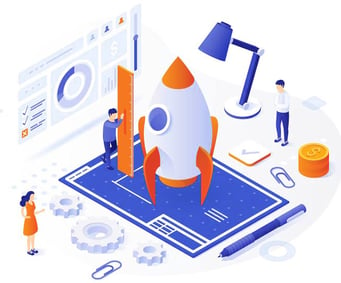 The advancement of software technology has fueled a change across the product manufacturing industry by integrating software into traditional hardware products. Consider thermostats, ovens, lights, garage doors, cars, machines, and even pet feeders.
The advancement of software technology has fueled a change across the product manufacturing industry by integrating software into traditional hardware products. Consider thermostats, ovens, lights, garage doors, cars, machines, and even pet feeders.
We now want to use digital devices to control our home devices from a distance. As a result, traditional hardware manufacturers have had to integrate software into their products, so we now live in smart homes with various smart objects containing software that can be monitored and controlled remotely.
Scale Production To Meet New Demands
Software integration into physical products has had a huge impact on product management. It has required industries to adapt production practices to accommodate new technologies. As products have grown in complexity, the need for new personnel to manage this expansion has also increased. Manufacturers are recruiting software teams to design and manage the new software technology. Before making these hiring decisions, it is important to have the resources in place to accommodate and integrate them into the production process.
Promote Close Collaboration Between Software and Hardware Teams
 The development of hardware products themselves is a complex process. It consists of putting together multiple components to build a finished product. With dependencies closely linked, the production process relies on product teams working together in alignment to finish within a specified timeframe. Many hardware teams have adopted a stage gate process as their product development lifecycle.
The development of hardware products themselves is a complex process. It consists of putting together multiple components to build a finished product. With dependencies closely linked, the production process relies on product teams working together in alignment to finish within a specified timeframe. Many hardware teams have adopted a stage gate process as their product development lifecycle.
The addition of software components to hardware products requires close collaboration between product teams. In many cases, software technology now provides the innovative aspect of the product, so software engineers essentially guide the development of the product. The hardware design must accommodate software composed of chips and other components and support new functionality. For example, in the case of a development that moves from a regular doorbell to a smart doorbell, a microphone, speaker, and camera must also be added to the mechanism. Software teams mainly adopt agile methodology and frameworks to manage their software development lifecycle. Agile methodology allows software teams to move at a more rapid pace and with less idle time. It is also essential for organizations that would like to attract top talent.
As a result, hardware product development lifecycles must cater to new ways of working so they can work in tandem with software teams. Communication tools promoting collaboration and clarity are vital to achieving alignment between these teams.
Integrate Software and Hardware Timelines into the Product Roadmap.
Hardware and software timelines are different. While each team will be guided by its own separate roadmaps to achieve specific goals, their process will integrate at some point before the launch date and must be reflected in the roadmap.
Product Development to Product Launch
 In the initial phase of developing the finished product, software product management has shorter lead times to create and test prototypes compared to the longer, more complex hardware development processes.
In the initial phase of developing the finished product, software product management has shorter lead times to create and test prototypes compared to the longer, more complex hardware development processes.
While the processes are different, hardware and software teams must collaborate closely and coordinate activities to develop the finished product. Building cross functional teams around sub-components and building up the hardware iteratively, using rapid prototypes such as 3d printing or digitization to create prototypes, is one way of bringing software and hardware teams closer together. In cases where the teams work separately, working against a joint roadmap will ensure there is alignment and transparency between the teams and that the interfaces are managed proactively. In such cases, product roadmap tools are essential to helping both sides manage the process effectively and communicate their dependencies.
Product Launch and Beyond
 The hardware cannot be easily changed when the physical product enters the market. However, the software evolves over time and can change how the hardware behaves. Software teams must continue to create new features and manage software updates long after the initial launch. This will require continued market research to keep the software current and meet the consumer's needs.
The hardware cannot be easily changed when the physical product enters the market. However, the software evolves over time and can change how the hardware behaves. Software teams must continue to create new features and manage software updates long after the initial launch. This will require continued market research to keep the software current and meet the consumer's needs.
Continued transparency and visibility of a joint roadmap between software and hardware teams is essential to track dependencies and coordinate changes for new or existing hardware. In addition, it is essential to keep marketing teams in the know as they manage sales campaigns to promote awareness of these new features.
The Advantage of Software Technology
While integrating software into hardware products requires a large-scale reorganization of the production process, there are several advantages to doing so.
Better Products in the Same Hardware
 There was a time when better products equated to overhauling the design or mechanical function of the product. This was a time-consuming, labor-intensive process that often required the reorganization of production to develop new features. Today that has changed.
There was a time when better products equated to overhauling the design or mechanical function of the product. This was a time-consuming, labor-intensive process that often required the reorganization of production to develop new features. Today that has changed.
Improving and updating software in a product is much easier than updating the design.
Incorporating software into traditional hardware products offers the advantage of improved functionality for the user. Consider smartphones that offer mobile payment apps. Smartphones already had security features such as passcode and facial recognition built into the software, so software designers had to simply create a virtual wallet app.
Such features do not require developing new hardware technology or changing the design of the phone. Software integration offers a huge advantage to product developers because they can improve their products and stay relevant in the market by using software innovations to stand out.
User Data For Improved Decision Making
 While product users benefit from new software features that they can download through an internet connection, manufacturers also benefit in a big way. When you integrate software into your hardware, you suddenly have access to user data.
While product users benefit from new software features that they can download through an internet connection, manufacturers also benefit in a big way. When you integrate software into your hardware, you suddenly have access to user data.
Software integration provides the advantage of tracking product usage. By collecting customer data, a business can gain insights into the user experience. This method of collecting product feedback gives quantitative data that can be used to inform product decisions. This, in turn, will be used to improve the customer experience. It is important to generate data, analyze it and use it to make future product decisions.
Setting Up New Support Systems
When introducing software into traditional hardware products, you need to create new systems for managing the software.
Customer Support Teams
Prior to integrating software, customer support teams dealt with largely physical problems with the product. Software integration requires personnel who are equipped with more technical skills. You also need to create a platform to provide software updates and remote support options when problems arise.
Deployment and Distribution Infrastructure
The infrastructure needs to be in place to transmit the software to the hardware when it’s in the hands of the customer. For example cars will need to have access to the internet to be able to download and update the software to enable new or improved features, or to fix issues with the function of the car.
Data Analysis Teams
The ability to collect valuable user information will require data collection tools. The gathered data needs to be analyzed promptly to gain useful insights that a product manager can act upon. Connecting customer relationship management software to product roadmap software for effective data analysis generates relevant and actionable information.
Gocious is a provider of Product Roadmap Management Software for companies that work at scale and need transparency and alignment across teams, specifically senior management. Find out more about the Gocious Product Roadmap Management Software by booking a demo with us. We’ll meet with you to show you around the program, get to know your needs, and discuss software features and how you can make them work for you and your company.


